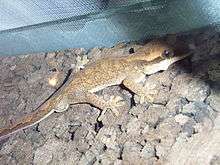Correlophus sarasinorum
Correlophus sarasinorum,[3] also called commonly Roux's giant gecko, Sarasins' giant gecko, Sarasin's [sic] giant gecko (incorrectly), and the suras gecko, is a species of lizard in the family Diplodactylidae. The species is native to the southern portions of the outlying New Caledonian island of Grande Terre.
| Correlophus sarasinorum | |
|---|---|
 | |
| Scientific classification | |
| Kingdom: | Animalia |
| Phylum: | Chordata |
| Class: | Reptilia |
| Order: | Squamata |
| Family: | Diplodactylidae |
| Genus: | Correlophus |
| Species: | C. sarasinorum |
| Binomial name | |
| Correlophus sarasinorum (Roux, 1913) | |
| Synonyms[2] | |
| |
Etymology
The specific name, sarasinorum (masculine, genitive, plural), is in honor of Swiss zoologists Karl Friedrich Sarasin and Paul Benedict Sarasin, who were cousins.[4]
Conservation status
C. sarasinorum is currently being evaluated by CITES for protective status and is considered vulnerable to extinction in many herpetological circles. It has been found only in six locales in its native habitat.
Description
Since there is a considerable variation in snout-to-vent length (SVL) of C. sarasinorum, which ranges from 3.5 to 5.5 inches (9 to 14 centimeters), it has been suggested that more than one subspecies exists; there is no universal consensus on this point. The basic color of the suras gecko is brown to gray. Two color patterns exist. A white spotted version is the recessive trait, and a white "V" pattern is the dominant trait. The gecko's appearance has often been described as similar to a large Correlophus ciliatus, with larger eyes.
Habitat
The preferred natural habitats of C. sarasinorum are forest and shrubland, at altitudes of 20–600 m (66–1,969 ft).[1]
Behavior
C. sarasinorum is nocturnal, and less arboreal than the other Rhacodactylus (sensu lato) geckos. It is often found hiding under the leaf litter or under loose bark. This species has an animal instinct of sleeping on top of plants or in small trees face up preventing the common FTS (Floppy Tail Syndrome) caused by the gecko sleeping upside down.
Diet
C. sarasinorum is an omnivore and is also considered to be frugiverous. In the wild it eats insects and fruit.
Reproduction
The female C. sarasinorum lays two eggs which are buried in a soft, damp substrate. The eggs hatch 60–90 days after being laid.
In captivity
The species C. sarasinorum is sometimes seen in captivity. A pair may be kept in a 20-gallon (76-liter) "high" terrarium.
References
- Sadlier RA, Whitaker AH (2018). "Correlophus sarasinorum (amended version of 2011 assessment)". The IUCN Red List of Threatened Species. IUCN. 2018: e.T176213A7198085. doi:10.2305/IUCN.UK.2011-1.RLTS.T176213A7198085.en. Retrieved 14 January 2018.
- Species Correlophus sarasinorum at The Reptile Database www.reptile-database.org.
- Bauer AM, Jackman TR, Sadlier RA, Whitaker AH (2012). "Revision of the giant geckos of New Caledonia (Reptilia: Diplodactylidae: Rhacodactylus)". Zootaxa 3404: 1–52. (Correlophus sarasinorum, new combination).
- Beolens, Bo; Watkins, Michael; Grayson, Michael (2011). The Eponym Dictionary of Reptiles. Baltimore: Johns Hopkins University Press. xiii + 296 pp. ISBN 978-1-4214-0135-5. (Rhacodactylus sarasinorum, p. 233).
Further reading
- Roux J (1913). "Les Reptiles de la Nouvelle-Calédonie et des îles Loyalty ". pp. 79–160 + Plates IV-V. In: Sarasin F, Roux J (1913). Nova Caledonia: Forschungen in Neu-Caledonien und auf den Loyalty-Inseln: Recherches scientifiques en Nouvelle Calédonie et aux Iles Loyalty. A. Zoologie. Vol. I - L. II. Wiesbaden: C.W. Kreidels Verlag. pp. 79-499. (Rhacodactylus sarasinorum, new species, pp. 99–102 + Plate IV, figures 6, 6a). (description in French).
